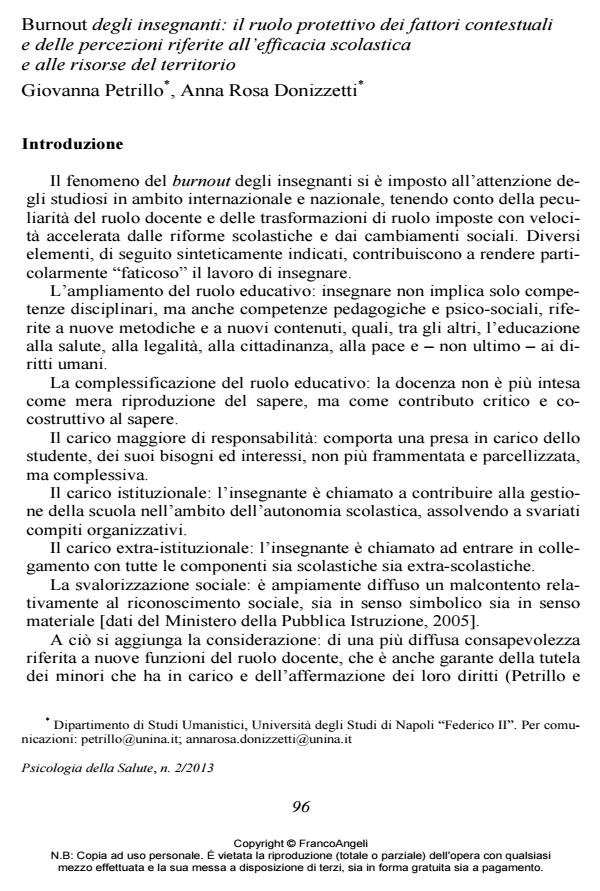Teacher burnout: the protective role of contextual factors and perceptions related to school efficacy and territorial resources
Journal title PSICOLOGIA DELLA SALUTE
Author/s Giovanna Petrillo, Anna Rosa Donizzetti
Publishing Year 2013 Issue 2013/2
Language Italian Pages 24 P. 96-119 File size 415 KB
DOI 10.3280/PDS2013-002007
DOI is like a bar code for intellectual property: to have more infomation
click here
Below, you can see the article first page
If you want to buy this article in PDF format, you can do it, following the instructions to buy download credits

FrancoAngeli is member of Publishers International Linking Association, Inc (PILA), a not-for-profit association which run the CrossRef service enabling links to and from online scholarly content.
The literature on teacher burnout explored the relationship between burnout and the factors that contribute or that can protect from this risk. The effect of the school environment (normal or at risk for dropout and delays of students), teachers’ believes in school efficacy, and related to territorial resources in which the school is situated on teacher burnout is less explored. These variables were considered in this study with the aim to analyze its protective role against burnout. Participants were 174 high school teachers, which were administered the Collective Efficacy Scale linking school context, Perception of Territorial Resources Scale and Maslach Burnout Inventory. The results of the multiple regressions confirm the protective function of the school collective efficacy and territorial resources for burnout and particularly for the dimension of personal accomplishment; while the perception of territorial resources remains significant negative predictor of depersonalization and emotional exhaustion. These results are in line with new approaches to burnout, considered as a construct arising not only from individual, but also organizational and social factors. The results of the study may be useful to design strategies to prevent teacher burnout focused on strengthening of the relations between teachers and other educational components, as well as the strengthening of human, materials and environment resources in the local area of the school.
Keywords: Teachers burnout, collective efficacy, territorial resources, school context
- The English Version of the Health Profession Communication Collective Efficacy Scale (HPCCE Scale) by Capone and Petrillo, 2012 Vincenza Capone, Leda Marino, Anna Rosa Donizzetti, in European Journal of Investigation in Health, Psychology and Education /2020 pp.1065
DOI: 10.3390/ejihpe10040075 - The effects of implicit ethnic expectations and burnout on teachers’ evaluations of students’ performance Sara Costa, Sabine Glock, Sabine Pirchio, in Intercultural Education /2024 pp.691
DOI: 10.1080/14675986.2024.2420570 - Protective and risk social dimensions of emergency remote teaching during COVID‐19 pandemic: A multiple mediation study Fortuna Procentese, Flora Gatti, Emiliano Ceglie, in Journal of Community Psychology /2023 pp.67
DOI: 10.1002/jcop.22879 - Mental health in teachers: Relationships with job satisfaction, efficacy beliefs, burnout and depression Vincenza Capone, Giovanna Petrillo, in Current Psychology /2020 pp.1757
DOI: 10.1007/s12144-018-9878-7
Giovanna Petrillo, Anna Rosa Donizzetti, Burnout degli insegnanti: il ruolo protettivo dei fattori contestuali e delle percezioni riferite all’efficacia scolastica e alle risorse del territorio in "PSICOLOGIA DELLA SALUTE" 2/2013, pp 96-119, DOI: 10.3280/PDS2013-002007